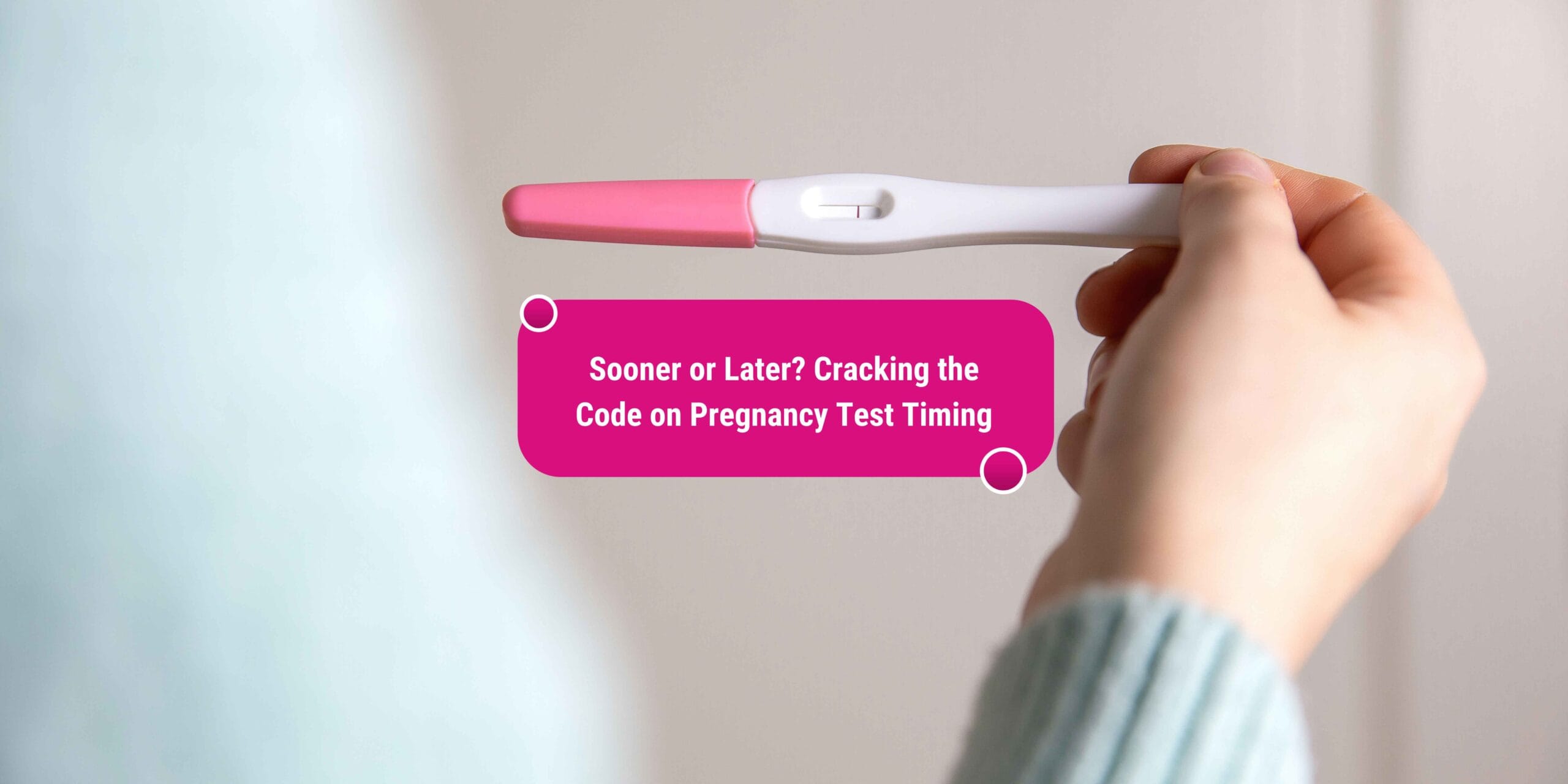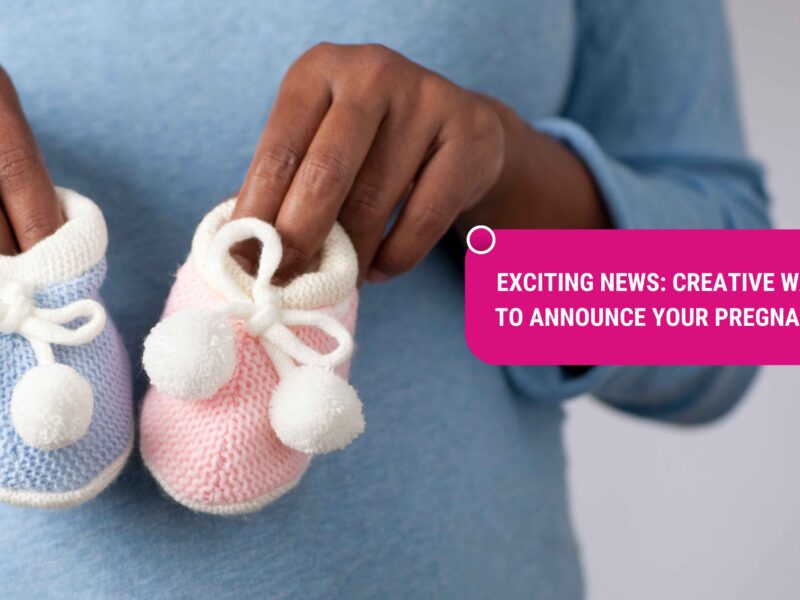When it comes to at-home pregnancy tests, they fall into two main categories: over-the-counter urine tests and laboratory-grade blood tests. From there, they can be subdivided into two more categories: standard tests, which are designed to detect the presence of hCG in urine/blood, and early result tests, which are also designed to detect hCG but are built to detect lower levels of the hormone but can contain more false negative or incorrect results. Blood tests, in general, are more sensitive and accurate than urine tests, as they can detect a pregnancy earlier in the process. Additionally, since blood is collected from the vein, it’s a lot harder for a human user to mess up the result. However, because blood tests are done in a laboratory, it’s a longer, more involved process.
If you are trying to get pregnant, you may find yourself wondering “How soon can you take a pregnancy test?” It’s a valid question. After waiting out two heart-wrenching weeks between the moment you think you’ve conceived and the moment you can finally take a pregnancy test, the anticipation is intense, to say the least. So, when should you take a pregnancy test? The most popular answer you’ll get from the internet is to wait until you miss your period. However, the actual answer is pretty complicated and depends, in part, on which type of pregnancy test you are using.
Types of Pregnancy Tests
1.1.1 Urine Testing – This standard method of pregnancy testing measures the presence of hCG in a woman’s urine. Female patients may get a home test kit to use at home, or they may go to their doctor’s office. Patients must collect a small urine sample for this kind of pregnancy test. Test strips are urinated on in a home test kit, allowing them to detect pregnancy. Alternatively, urine samples are produced by women in a doctor’s office, and the presence of hCG is tested on site. 1.1.2 Blood Testing – This type of blood test analyzes the presence of hCG in the blood, and is performed in the doctor’s office. As mentioned above, the presence of hCG in the blood verifies a diagnosis of pregnancy earlier than a urine test would. Blood results can show levels of hCG as low as 25 IU/L, and doctors can carry out the test within one week of conception. Both blood tests for pregnancy can also help to determine gestation time. Pregnant women can also use blood tests to determine if they have an ectopic pregnancy.
Women have more options than ever for at-home pregnancy tests. But before they take that first pee, it would help them to know that whether they wait an extra day or two or start waving a test stick around or ignore everything about timing, they’ll have very similar odds of finding out whether they’ve got a baby on the way. Women can’t get a positive home pregnancy test as soon as they conceive—nope, there are a few days of urine tests and research that need to be looked at. Pregnancy tests are majorly of two types: the urine test detects the human chorionic gonadotropin (hCG) in their urine, while the blood test detects the presence of hCG in blood. This section will give patients an understanding of the differences between traditional pregnancy urine tests and one blood test for pregnancy.
Understanding the Menstrual Cycle
The rise in hormones that fills the human embryo comes early. In fact, it occurs 36 to 40 hours after ovulation – some 6-10 days before the missed period. However, the resulting hormone hit is not enough for standard over the counter pregnancy tests. In fact, the best time to take the test is at least the day following your due date. Yes, that will require you to hold out for a while and ignore the butterflies in your stomach! Dr G is frequently asked if there are better times of day than others for taking a pregnancy test. The answer is stark – choose a time and stick with it. If you test at 7am on Tuesday, then every morning from then on in must be a 7am time. Puberty hit me at 7pm on a Friday and that’s the time my monthly reminder hits – ringing me not to ever forget again!
A menstrual cycle is counted from the first day of bleeding in one month to the first day of bleeding in the next – with most people experiencing 11 to 13 menstrual cycles each year. Generally, a new menstrual cycle starts on the eighteenth to the twentieth day after conception. Sometimes the cycle might start earlier, in which case you count back 16 to 18 days. If a person has a sudden drop in body temperature ahead of this time and a subsequent spike, then it might be time to do a test because that could indicate that hormonal changes are currently taking place in the body – it is also likely, however, that it is simply your body going through an irregular, new cycle. If you wish to determine the time of ovulation exactly, you might also wish to use an ovulation test. Ovulation occurs 36 to 40 hours after a positive test result. The best time for a pregnancy test is at least the first day after the due date, so as to be sure that the body has sufficient hCG for test detection.
Phases of the Menstrual Cycle
Estrogen levels begin to drop as progesterone rises in the luteal phase. If the mature egg is fertilized by a sperm, the fertilized egg forms a zygote and travels down the fallopian tubes to the uterus. It may take between 4 and 7 days to implant. If the egg is not fertilized, it’s reabsorbed by the body, and estrogen and progesterone levels drop precipitously, signaling the start of menstruation. On average, the luteal phase is about 14 days long. The luteal phase’s length remains relatively consistent for each woman from cycle to cycle. However, the follicular phase can significantly fluctuate (from 7 to 40 days), which is why menstruation is not always predictable. So, when you ovulate in a cycle dictates when menstruation will begin—14 days later.
The menstrual cycle has two main phases: the follicular phase and the luteal phase. The follicular phase begins on the first day of menstruation and is typically about 12 to 21 days long. During this phase, follicle-stimulating hormone (FSH) stimulates the ovaries to produce up to 20 immature egg follicles. Of these, only one egg follicle will be selected for ovulation, while the rest are usually reabsorbed by the body. As the follicular phase continues, the cells in the egg follicle proliferate, producing estrogen. While initially low, estrogen levels peak in the strictly controlled estrogenic mid-cycle surge. At this point, luteinizing hormone (LH) leaps. This is called the LH surge and it triggers ovulation—releasing the mature egg from the egg follicle. The LH surge typically takes place about 36 hours before an egg is released, though in some cases it can be a few days longer or shorter.
When to Take a Pregnancy Test

However, when a high level of LH is produced again, you may be experiencing “LH-P”. This is LH that gives one last “surge” before the menstrual cycle starts. An ovulation test can, therefore, help distinguish which “positive” may be “real” or “LH-P”. As indicated above, an ovulation test can act as a “pregnancy test”. While an ovulation test can seem a bit wasteful, many women find that they have some extra that they received when they were trying to figure out their cycle and no longer used them as pregnancy tests. When to Take a Pregnancy Test Based on Your Menstrual Cycle How early is too early to take a pregnancy test? You would do well to take a pregnancy test no sooner than 10 days after a confirmed ovulation vertically two vertical lines on an ovulation test and at normally one temperature. And your next menstrual cycle has not come to that if you want an immediate answer! In other words, it is possible to be positive before you expect ovulation, very early in a cycle that is not a menstrual one.
Many women and couples who are trying to conceive are anxious to find out if their efforts have been successful and to learn about it as early as possible. For those who do not chart their cycles, this is generally the first sign that they missed a fertile day or whose menstrual cycles are not regular. Days when LH fertility hormones are higher than normal are “positive” and are generally identified 36 hours before ovulation, as many women ovulate. Now, from your linked question, an increase of LH hormones/”positive” around 12 May was not an indication of ovulation on May 14 since ovulation generally occurs within 36 hours from “positive”, i.e. on May 13/15.
Factors Affecting Test Accuracy
In summary, a pregnancy test pushed to 6 days prior to the expecting period is recommended because it provides results close to a urine test. The likely triggers of the early detection of false negatives were explored. The accumulation and distribution of hCG was discussed in the pregnancy tests, the early pregnancy hormone. The business of at-home pregnancy tests was built in insecurity and goodness. There are few problems that result in expensive mistakes and complications with only two possible answers (positive and negative). Pregnancy tests are subject to day trading so that women are more likely to continue buying multiple test results.
Due date calculators usually only work under the highest levels of ideal circumstances. Low levels of circulating hCG in the immediate post-implantation period can result in the following: invariable sperm position, slow swim, or uterine wall time may result in a heathen conception time. The lifestyle and odds of the individuals. Research suggests that annual pregnancy tests are rarely accurate with levels as low as one-to-three days.
1. An enviable lack of hCG 2. Irresponsible urine
Many women expect to see positive pregnancy test results when they take early detections, yet the likelihood of receiving a false negative outweighs that of receiving a true positive. Only 55% of pregnant women received a positive result with only one and as many as 4% continued to receive negative results 14 days following their first positive. Moreover, there are many reasons why women receive false-negative results when taking early detection tests.
Interpreting Test Results
There are tens of stories about women buying pregnancy kits and getting a faint line. Afterward, they took the same brand of pregnancy test, with the same lot number, and tested again, only to see pregnancy test results go from positive to negative. What’s going on? Chances are, they might not be pregnant. Also, chemical pregnancy is a pregnancy that ends in miscarriage before the sixth week. Chemical pregnancies start like regular pregnancies and implant in your uterus, they can produce a positive result on a pregnancy test. These results are nothing more than an evaporation line, which is generally colorless in nature and, just like chemicals evaporating in the air, tends to occur after the manufacture-evaporated dye in a pregnancy test runs the specified course across the result indicator.
At-home pregnancy tests are meant to be relatively foolproof in terms of providing easy-to-understand results. To interpret a test properly, you’ll need to know when to take the test and how to properly understand the results. Timing is important when you take a pregnancy test. If you don’t wait long enough after taking the test, the results could be misleading. If you’re feeling antsy, chances are you want to know if you’re pregnant as soon as possible. While that’s certainly understandable, it’s important to remember that tests on the market have different thresholds for detecting hCG. In general, testing with a very early pregnancy test, one with a sensitivity threshold of 25 mIU/hCG or 20 mIU/hCG, for example, can detect smaller amounts of hCG and potentially tell you earlier on if you are pregnant than when testing with an at-home pregnancy test with a sensitivity threshold of 50 mIU/hCG or 100 mIU/hCG, for example. Tests become increasingly accurate over time – with one about a week after your missed period. If you don’t take the hCG test after enough time has passed, you may miss out on the hCG in your body altogether.
Understanding Evaporation Lines
What is an Evaporation Line? It is easy to confuse an indent with an evaporation line. “An indent is where a line should appear, but it doesn’t pick up any color” and is a sign of a faulty test. An evaporation line is a “water mark” produced by the evaporation of the test liquid. This can happen when tests take too long to interpret. Some tests may take only two to three minutes, but others may take up to 10 minutes, when there may be a faint evaporation line. “This usually has an indent that you can see, versus a 10-minute standard where it may be hard to see the indent.” As an HCGSurge moderator has explained, all tests suffer from fading, and no test “has a special protective film over the test line to prevent evaporation.”
Evaporation: Over time, the moisture from the control and test lines can evaporate, leaving a visible sign of where the lines once were. According to HCGSurge, “liquid evaporation may react with air at the test vents and may form an additional line there, which should neither be confused with positive results nor an evaporation line. However, that is also to be scrutinized closely by the manufacturers for correcting the design or executing plastic injection.”
Key Takeaways
Because a very early embryo may implant successfully into a woman’s dead zone, many women with low-tissue HB-EGF expression attempt conception in any given month. Now, for the first time, we have quantified for the biomedical community how ultrasound sonographers can take a two-dimensional observation and be confident as to which immunity and endometrial tissue types are directly in the embryonic implantation cross-hairs of anatomic-success zone. For couples trying to become pregnant, there are stark implications. With this information, we can produce wrappers for home pregnancy tests in relation to a pregnant woman’s menstrual cycle.
In conclusion, the answer to “how and when a woman’s menstrual cycle might impact the viability of an HPT?” is now clear: positivity depends greatly upon the threshold value used in hCG concentration. If a woman has a long serum half-life of hCG, minor hand-tuning of the detection threshold based upon serum hCG half-life will optimize the clinical sensitivity of a home pregnancy test. Developing urine-based point-of-care HPTs with a low enough detection threshold such that even “fast metabolizers” of hCG turn a qualitative positive result on the first day after a missed menstrual period will maximize the clinical sensitivity of the test. Furthermore, serum and urine hCG concentration are positively correlated only around the time of an embryo implanting. Women hoping to conceive and take a home pregnancy test may get reliable results one week after ovulation, whether her menstrual period has initiated or not.



